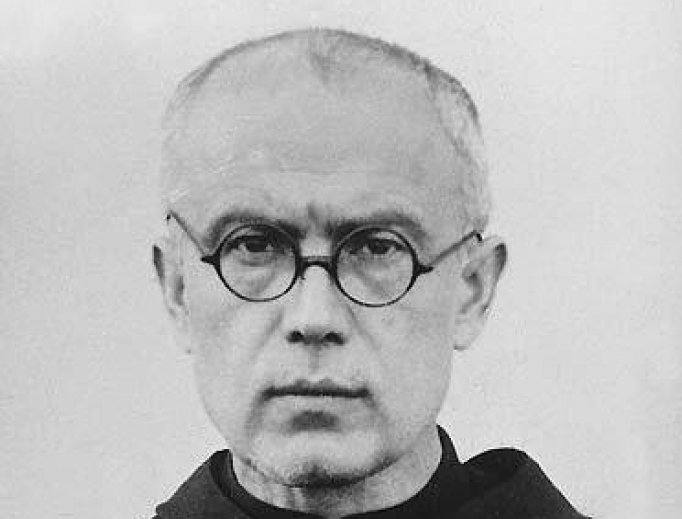St. Maximilian Maria Kolbe — a Martyred Giant for God
“Life begins to make sense when we recognize and acknowledge God’s infinite goodness and our absolute dependence on him,” said St. Maximilian Kolbe. “Our response will be praise and total love expressed in obedience.”

Last month, we commemorated the 80th anniversary of the martyrdom of Father Maximilian Maria Kolbe, a Polish Franciscan priest martyred by Nazis during World War II. His life offers a unique testimony of human strength in the times of the greatest cataclysm in the history of mankind.
On Jan. 8, 1894, in a humble family, Father Maximilian was born as Rajmund Maria Kolbe in Zduńska Wola, Poland. He was a child of faith early in life. In 1906 young Kolbe had a vision of the Virgin Mary. As he explained later: “That night I asked the mother of God what was to become of me. Then she came to me holding two crowns, one white, the other red. She asked if I was willing to accept either of these crowns. The white one meant that I should persevere in purity, and the red that I should become a martyr. I said that I would accept them both.”
The vision deeply affected him, and the following year young Kolbe and his elder brother both joined the Franciscan Conventual in Lwow. In 1910, he was given the religious name Maximilian and was admitted as an initiate. He took his final vows as a monk in 1914. First, he gained his doctorate in philosophy at the Pontifical Gregorian University in Rome and then he obtained a doctorate in theology from the University of Saint Bonaventure (called Seraphicum), also in Rome.
After completing his studies, Kolbe returned to the independent Poland in 1919. After several postings around the country, he decided to build a monastery at Niepokalanow. It eventually became the world’s largest with over 700 brothers. Father Maximilian became a very active shepherd in his work for the conversion of sinners and enemies of the Catholic Church.
He devoted himself to the Marian cult and proclaimed his will to fight for the Mother of God against the enemies of the Church. He became father superior of the City of Mary Immaculate and director of Poland’s chief Catholic publishing complex. With the Militia Immaculata, he organized the Immaculata Prayer, the consecration to the immaculately conceived Virgin Mary. He also helped Immaculata Friars to publish books, pamphlets, essays and a daily newspaper – Little Daily (Mały Dziennik). Father Kolbe also secured a radio broadcasting license to beam good news on religion. Attacking godlessness in all its forms, the message was strongly anti-Communist and anti-Nazi.
Additionally, Father Kolbe helped the poor in their daily economic activities. He taught them how to organize their work and how to put to use all their resources together. He showed them how to become independent and self-empowered, particularly through cooperatives. Finally, he helped them to experience the dignity of labor and escape unemployment.
In 1930 the priest set off for the Far East. He spent several years in Japan as a missionary. He founded a monastery on the outskirts of Nagasaki, which, by the way, miraculously survived the atomic blast. However, because of illness, Father Kolbe had returned to Poland already in 1936.
Father Maximilian settled back in Niepokalanow, and continued his good works, including fostering technological innovations (e.g., developing a TV station). When the Second World War broke out in 1939, Poland was overrun by the Germans and the Soviets. Niepokalanow was conquered by the Nazis. The Gestapo — their secret police — arrested the priest along with 40 other religious. After a stay in three different camps he was released in December 1939.
Father Kolbe returned to Niepokalanow, where he tended to refugees and fugitives, both Christians and Jews. He also set up a welfare outfit to benefit the local needy.
The Germans resolved to put paid to such activities, in particular sheltering Jews. In February 1941 Father Kolbe was rearrested and dispatched to a prison in Warsaw, and then to Auschwitz, where in May 1941 he became prisoner no. 16670. Despite extremely difficult conditions, he retained a deep faith and dignity.
In July 1941, following an inmate’s escape, as punishment, the SS selected 10 prisoners to be starved to death in an underground bunker. Maximilian Maria Kolbe volunteered his life in the place of Franciszek Gajowniczek. When an incredulous SS officer asked why, Father Kolbe responded, “I am a Catholic priest from Poland. I would like to take his place because he has a wife and children.”
Father Kolbe and the other prisoners were starved for weeks until he and a few others who had clung to life were finally given a deadly injection. As John Paul II later said, “Maximilian did not die but gave his life … for his brother.”
He not only wore the red crown of martyrdom, but Maximilian Kolbe’s actions set him up as a new giant for God. Throughout his life, Saint Maximilian demonstrated that love is stronger that hatred and violence. He proved that love overcomes evil.
Today, Father Kolbe is a martyred giant and a symbol of courageous dignity. In a time of terror and evil, he restored faith and hope.
Father Kolbe was beatified as Confessor of the Faith by Pope Paul VI in 1971 and canonized by Pope John Paul II in 1982. He became the first Polish martyr of the Second World War to be raised to the altars.
St. Maximilian, pray for us!
- Keywords:
- st. maximilian kolbe
- auschwitz
- martyrs
















